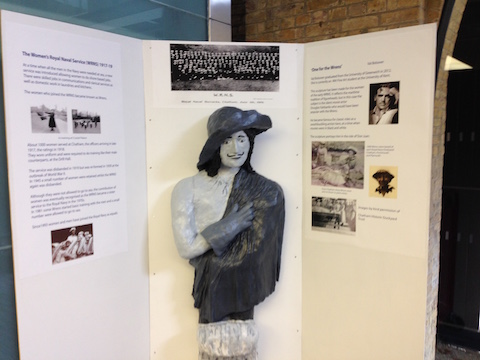
MA Fine Art student, Val Bolsover, has a new work, One for the Wrens, installed in the silent section of the Drill Hall Library on the Medway Campus. The site specific work is based on the existence of the Wrens in those Medway campus buildings and their lack of a figurehead. It is the centenary of the WRNS in 2017.
Said Val: “The piece came about for many reasons, which were brought together in my mind by being based at the Dockyard. I grew up around boats, and as a teenager in the 1970s, thought it would be great to join the Navy. For girls there were plenty of career options in the Women’s Royal Naval Service. When I discovered that women were not allowed to serve on ships and go to sea I changed my mind – what’s the point in joining a naval service which is always ashore?
The history of our association with the sea, whether naval, merchant, fishing or leisure, has until recent years been dominated by men. Ships and boats are traditionally named after women, and boats referred to as she. Until the late 19th Century naval and merchant ships carried a figurehead, most often a scantily dressed, buxom woman. These carved and painted figures were replaced by badges. Some figureheads lived on as sculptures ashore, where naval premises took the name of a former ship.
At times of war, women had been called on to assist with the forces to release trained men for war. There has been much publicity about how the physical labour of women in factories, and in agriculture, influenced opinion in the fight for votes for women following the First World War. Less attention has been given to the skilled tasks undertaken temporarily by women in the forces.
Bringing these thoughts together I wondered what sort of figurehead the wrens of the First World War would have appreciated. Perhaps a movie star of the time would have been their choice. It was still the era of black and white silent films. I chose Douglas Fairbanks, a contemporary and friend of Charlie Chaplin. He is painted black and white because that is how the wrens would have seen him. Appropriately the sculpture is currently in the silent section of the Drill Hall Library.”
For Drill Hall Library opening hours go to: http://campus.medway.ac.uk/about/opening.html
For more info on the artist go to: valbolsover.com